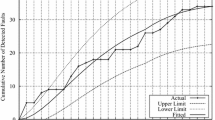Abstract
With the increasing demands on resources and skills needed to complete complex software projects, there is a steady move towards distributed working. Distributed software development is being made feasible owing to rapid advances in communication technologies. Distributed systems often involve development teams that are located across company sites, organizations, sectors and nations; as such there are special risks involved that are over and above the normal risks of software development. A distributed development project with some or all of the software components generated by different teams presents complex issues of quality and reliability of the software. The need is growing to estimate, risk assess, plan and manage the development of these distributed components and the final full system release. In this paper, an attempt has been made to compare Non Homogeneous Poisson Process (NHPP) based models in a distributed development environment. Proposed (NHPP) model assumes that the software system consists of a finite number of reused and newly developed sub-systems. The reused sub-systems do not consider the effect of severity of the faults on the software reliability growth phenomenon because they stabilize over a period of time i.e. the growth is uniform whereas, the newly developed sub-system does consider that. Fault removal phenomenon for reused and newly developed sub-systems have been modeled separately and is summed up to get the total fault removal phenomenon of the software system. The performance of SRGMs are judged by their ability to fit the past software fault data (goodness of fit) and to predict satisfactorily the future behavior of the software fault removal process (predictive validity)
Similar content being viewed by others
References
Akaike H., A New Look at Statistical Model Identification-IEEE Transactions on Automatic Control 1974; 19:716–723.
Bittanti, S., P. Bolzern, E. Pedrotti and R. Scattolini (1998), A Flexible Modeling Approach For Software Reliability Growth, in G. Goos and J. Harmanis, eds.: Software Reliability Modelling and Identification, Springer Verlag, Berlin, 101–140.
Brooks WD and Motley RW, Analysis Of Discrete Software Reliability Models-Technical Report (RADC-TR-80-84) (1980) New York: Room Air Development Center.
Downs T and Scott A., Evaluating The Performance Of Software Reliability Models, IEEE transactions on reliability (1992) 41(4): 532–538.
Goel AL and Okumoto K., Time Dependent Error Detection Rate Model For Software Reliability And Other Performance Measure-IEEE Transactions on Reliability (1979); R-28 (3): 206–211.
Kapur P.K., R.B. Garg and S. Kumar (1999), Contributions to Hardware and Software Reliability, World Scientific, Singapore.
Kapur PK and R.B. Garg (1992), A Software Reliability Growth Model For An Error Removal Phenomenon, Software Engineering Journal 7, 291–294.
Lyu M.R. (1996), “Handbook of Software Reliability Engineering”, McGraw Hill.
Misra PN, Software Reliability Analysis, IBM System Journal 22(3) (1983) 262–270.
Musa, J.D., Iannini, A. and Okumoto, K. (1987) Software Reliability: Measurement, Prediction, Applications, McGraw Hill.
Ohba, M. (1984), Software Reliability Analysis Models, IBM Journal of research and Development 28, 428–443.
Pfleeger SL, Software Engineering-Theory and Practice (1998), New Jersey: Prentice Hall.
Pressman Roger S., Software Engineering-A Practitioneer’s Approach-Fourth Edition, McGraw Hill.
Woodcock TG and Khoshogoftaar TM (1991), Software Reliability Model Selection: A case study, Proceedings Of The International Symposium On Software Reliability Engineering, pp. 183–191.
Yamada S, Ohba M, and Osaki S. (1984) S-Shaped Software Reliability Growth Models And Their Applications, IEEE Transactions on Reliability, 1984; R-33: 169–175.
Yamada S, Tamura Y and Kimura M, (2003), A Software Reliability Growth Model For A Distributed Development Environment-Electronics & Communication in Japan Part 3, Vol. 83, pp 1446–53.
Author information
Authors and Affiliations
Rights and permissions
About this article
Cite this article
Kapur, P.K., Gupta, A., Kumar, A. et al. Flexible Software Reliability Growth Models for Distributed Systems. OPSEARCH 42, 378–398 (2005). https://doi.org/10.1007/BF03398749
Published:
Issue Date:
DOI: https://doi.org/10.1007/BF03398749




